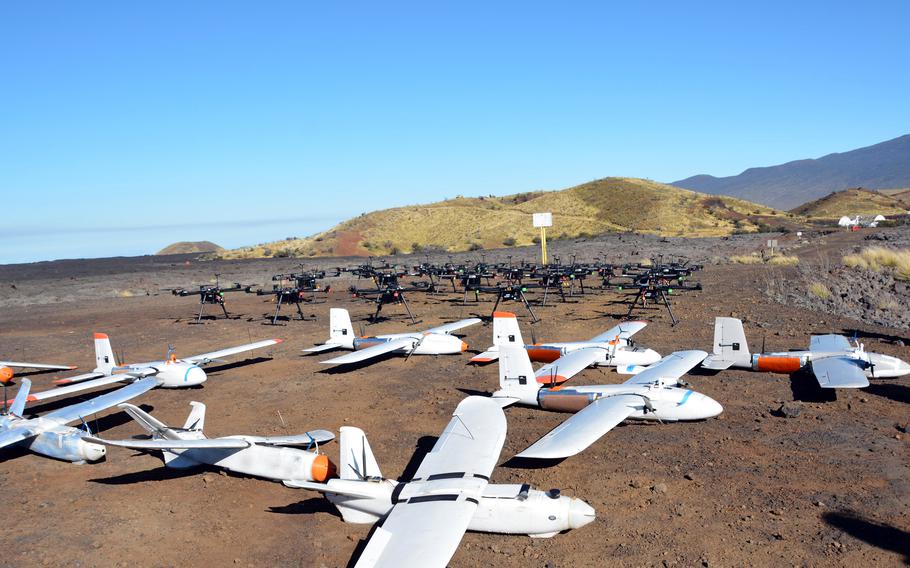
A small fleet of target drones awaits launching and ultimate destruction by the Marine Air Defense Integrated System, positioned atop the knoll in the background, during live-fire training at Pohakuloa Training Area, Hawaii, Jan. 25, 2025. (Wyatt Olson/Stars and Stripes)
(Tribune News Service) — The state Board of Land and Natural Resources voted Friday 5-1 to reject the Army’s final environmental impact statement on plans to retain state land on Oahu after leases expire in 2029.
The Army released the document in May, in which the Army stated that its preferred outcome was to vacate most of the state land it has leased with the state and consolidate its training onto federal land. However, ultimately staff across the Department of Land and Natural Resources concluded that the document — which also listed proposals that would see the Army retaining much more land — contained significant data gaps.
The vote came after a day of emotional testimony from members of the public, and included the arrest of a protester who disrupted the meeting as a community member was testifying. As DLNR officers hauled the protester away, another attendee who came to testify shouted “you’re not helping.” Overwhelmingly, those who came to testify called on the board to reject the FEIS.
Among criticism raised by those opposing the approval were charges that it used outdated environmental data and information on traditional burial grounds, and that the Army did not properly consult the Hawaii State Aha Moku Council. Army officials defended their efforts, citing a long list of prominent community members they consulted, studies they conducted and noting that they are currently working on other studies as well.
Many of the same complaints were raised against the Army’s FEIS for plans to retain land at the Pohakuloa Training Area on Hawaii island, which the BLNR also rejected in May.
The Army’s Oahu leased lands currently include 1, 150 acres at Kahuku Training Area, 4, 390 acres at Kawailoa-Poamoho Training Area and 782 acres at Makua Military Reservation. The Army obtained all those lands, along with a leased state parcel of 22, 750 acres at Pohakuloa, for a mere $1 in 1964. The leases expire in 2029.
In the Oahu EIS, the Army stated the preferred-alternatives section indicates that the service would prefer to lease only 450 acres at Kahuku and not pursue renewing leases on any state land at the other two sites—a roughly 93 % reduction.
The land board concluded that while it largely embraced the Army’s proposal to leave those lands and commended Army officials for speaking with local individuals and trying to comply with their standards, they ultimately agreed with DLNR staff that the document failed to meet the requirements of the state of Hawaii.
BLNR Chair Dawn Chang said that it was “rare ” for each division of the DLNR to comment on an EIS, and said their concerns prompted her and the rest of the board to ultimately reject the EIS. The lone vote against rejecting the FEIS was Riley Smith, who represents Hawaii island on the BLNR. He also was the lone vote against rejecting the FEIS for Pohakuloa.
“I understand the concerns with shortcomings in the EIS, ” Smith said. “I also appreciate the Army’s willingness and preferred recommended alternative to returning 5, 872 acres to the state of Hawaii. I feel that the denial of the EIS will slow down the return of 5, 872 acres back to the state. So because of that, because I want the show of good faith by the Army to move forward, I’m going to be voting against this motion.”
After the vote, Healani Sonada-Pale of the group Ka Lahui Hawai ‘i told the Honolulu Star-Advertiser “This is a win for the community, and it also is a sign that there’s a shift. People are more careful now moving forward and we’re not going to give the U.S. military a free pass on everything, and so the scrutiny that they went through the EIS with is commendable.”
“I’m glad they made the right decision, ” said Wayne Tanaka, director of the Sierra Club of Hawaii. “The state hasn’t always held the military accountable to our laws and to our island, and in this case, it seems it has, so I’m grateful for that.”
In a statement after the vote, U.S. Army Garrison Hawaii said that “the published FEIS was achieved with input from the local community.” The statement also quoted Garrison Commander Col. Rachel Sullivan saying that the Army “is committed to continuing its environmental and cultural stewardship in support of the U.S. Army Pacific training strategy while maintaining an enduring partnership with O ‘ahu communities.”
In a press conference with reporters after the vote, Chang said that this is just one step in the land negotiating process, which remains ongoing.
“No one that I heard on the land board is saying we want (the Army ) to leave, we want them to comply with the law, ” she said. “We want them to hear what the communities have to say, to engage with them in a genuine way before they come back to the lab work. So I’m hoping that’s the message that came across today.”
© 2025 The Honolulu Star-Advertiser.
Visit www.staradvertiser.com.
Distributed by Tribune Content Agency, LLC.